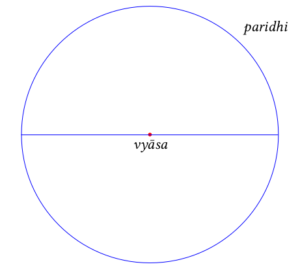Indian Mathematicians and the Value of Pi
- Anaadi Foundation

- Aug 24, 2021
- 3 min read
India has been a cradle not only to refined civilizational best-practices but also to multitudinous scientific developments. Evidence and knowledge of voluminous literature produced in Indian scientific pursuits has been well established by serious researchers. In contrast, there is prevalent ignorance about facts and feats that we have inherited.
Through a series of short articles, we have set forth to cover a few highlights in the development of Jyotiṣa (Astronomy) and Gaṇitā (Mathematics). The development of both these fields can broadly be put in three eras:
Vedic or Pre-Siddhantic Era,
Siddhantic or Classical Era and
Post-Siddhantic or Medieval Era.
Having delved into the Vedic period, we have moved ahead in the timeline and presented an introductory glimpse into the phenomenal breakthroughs in Chandas-śāstra composed by Piṅgala-nāga around 3rd century BCE. In this article, we shall cut across the timelines of the three eras of development of mathematics in India in order to appreciate how India’s contribution to approximating π is immensely significant. The recent date that passed — 22nd of July is celebrated as world π day. We will throw an interesting light on for how long Indians have ruminated on π and have significantly contributed to better approximations in the global stage.
What is really π?
Since the Vedic era Indian mathematicians have been dealing extensively with the geometry of the circle and have always tried to estimate this value as the ratio between the circumference (paridhi/parinaha) to the diameter (vyāsa/viṣkambha) of the circle (vṛtta). Bharatiya Ganita Parampara knew that this number cannot be expressed as a fraction and hence it is a surd. Nonetheless for practical purposes such as construction, area transformation and in various places of math and astronomy, Indian mathematicians approximated the value of π and have strived immensely to improve the efficiency.

Significant leaps related to π
The Śulvasūtras (c. 800 BCE) give the value of π close to 3.088. Śatapathabrāhmaṇa (<600 BCE) gave 25/8 = 3.125 correct to 1 decimal place (Geometric method).
In Āryabhaṭı̄ya (499 CE), the magnum opus of Āryabhaṭa, an approximation which is correct to four decimal places is present.चतुरधिकं शतमष्टगुणं द्वाषष्टिस्तथा सहस्राणाम्।
अयुतद्वयविष्कम्भस्य ‘आसन्नो’ वृत्तपरिणाहः ॥
One hundred plus four multiplied by eight and added to sixty-two thousand.
This is the approximate measure of the circumference of a circle whose diameter is twenty-thousand.
Thus as per the above verse, the approximated value for is 62832/20000 = 3.1416. And this is correct to four decimal places and highly valuable for precision in practical aspects.
The same value has been given by Bhāskarācārya II (1114 CE) in Lı̄lāvatı̄ by removing a factor of 8 from the denominator and the numerator. The numbers employed by Bhāskara are in Bhūta-saṅkhya system.व्यासे भनन्दाग्निहतेे विभक्ते खबाणसूर्यैः परिधिः स सूक्ष्मः।
द्वाविंशतिघ्ने विहृतेऽथ शैलैः स्थूलोऽथवा स्याद्व्यवहारयाेग्यः~॥१९९॥
When the diameter is multiplied by 3927 and divided by 1250, that [result-
ing] circumference is near precise. Else, if [the diameter is] multiplied by
22 and divided by 7, then [the resulting circumference] would be a gross
[value] good for practical use.
The following accurate value of π (correct to 11 decimal places) has been given by Mādhava (c. 1340 CE), who is the pioneer of the Kerala school of astronomy and mathematics. विबुधनेत्रगजाहिहुताशनत्रिगुणवेदभवारणबाहवः।
नवनिखर्वमिते वृतिविस्तरे परिधिमानमिदं जगदुर्बुधाः॥
The π value given above is: π = 2827433388233 / 9 x 1011 = 3.141592653592…
The 13 digit number appearing in the numerator has been specified using the Bhūta-saṅkhya system, whereas the denominator is specified by word numerals. In the Bhūta-saṅkhyā system, vibudha =33, netra =2, gaja =8, ahi =8, hutāśana =3, triguṇa =3, veda =4, bha =27, vāraṇa =8, bāhu =2. In word numerals, nikharva represents 10 11. Hence, nava-nikharva = 9 × 10 11.
Only in 1706 CE William Jones made Greek π as this ratio’s notation. In 1914 CE Srinivasa Ramanujan derived a set of infinite series that seemed to be the fastest way to approximate π. However, these series were never employed for this purpose until 1985, when it was used to compute 17 million terms of the continued fraction of π (Modular Equation method).
As of Jan 2020 we have 50 trillion terms of π by algorithms(Modular Equation method). It is important to also celebrate the lineage of Indian mathematicians who achieved breakthroughs that continuously advanced π, impacting our leaps in allied areas of trigonometry, and calculus.
It is indeed enthralling to know in depth about the rich scientific heritage of the Indian civilization. We shall continue to see other ingenious achievements in Indian mathematics in the following editions of Parnika.
Aum Tat Sat!



Comments